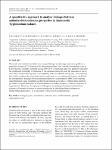A quantitative approach to analyse linkages between antimicrobial resistance properties in Salmonella Typhimurium isolates
Ruddat, I.
Schwarz, S.
Tietze, Erhard
Ziehm, D.
Kreienbrock, L.
This study used statistical methods to investigate linkages in phenotypic resistance profiles in a population sample of 321 Salmonella Typhimurium isolates from sporadic salmonellosis cases in Lower Saxony, Germany, collected during 2008–2010. A resistance index was applied to calculate the conditional probability of resistance to one antimicrobial agent given the resistance to one or more other antimicrobial agent(s). A susceptibility index was defined analogously. A contingency plot, which visualizes the association between resistances to two antimicrobial agents, facilitated the interpretation. Linkages between minimum inhibitory concentrations (MIC) were analysed using Spearman's rank correlation coefficient and jittered scatter plots. Applying these methods provided a compact description of multi-resistance and linkages between resistance properties in large datasets. Moreover, this approach will improve monitoring of antimicrobial resistance dynamics of bacteria in human or animal populations by identifying linked resistance to antimicrobial agents (cross- or co-resistance) with a non-molecular method.
No license information

